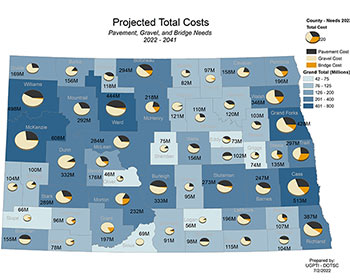North Dakota's County, Township and Tribal Roads and Bridges: 2022-2041
Posted: Aug 9, 2022
 The draft of "Infrastructure Needs: North Dakota's County, Township, and Tribal Roads and Bridges, 2022-2041" is now available online. Additionally, info from the July regional meetings are also posted online and provide a good means to understand the data collection and analysis processes. The report is open for public comment until August 25, 2022.
The draft of "Infrastructure Needs: North Dakota's County, Township, and Tribal Roads and Bridges, 2022-2041" is now available online. Additionally, info from the July regional meetings are also posted online and provide a good means to understand the data collection and analysis processes. The report is open for public comment until August 25, 2022.
The study is the sixth biennial local road investment need study conducted by UGPTI since 2010. "With each study we've improved the quality and scope of the data collected and the quality of the analysis methods," explained Alan Dybing, a UGPTI economist and one of the researchers leading the project. "The intent is to provide the most comprehensive analysis of North Dakota's local roads and bridges."
The 2019-2021 Study noted a 20-year investment need of $9.3 billion. The current 2021-2023 Study reports that North Dakota will need to invest more than $10.5 billion over the next 20 years to maintain local, township and tribal roads and bridges, an increase of 14% over the last biennium. The current needs include $6.5 billion for unpaved roads, $3.25 billion for paved roads and $715 million for bridges.
The local roads research report responds to the N.D. Legislature's request for a study of the transportation infrastructure of all county, township, and tribal roads and bridges in the state. Infrastructure needs were estimated using traffic estimates, Geographic Roadway Inventory Tool (GRIT) data, roadway condition data, crop and oil forecasts and detailed traffic models. The data from the Study will be used in the county distribution formula for Operation Prairie Dog (OPD).
UGPTI researchers are receiving public comments on the report until August 25. Public review and feedback are critical to provide an accurate assessment of our local roadway system. Report feedback and questions can be submitted to the UGPTI research team at ndsu.roadneeds@ndsu.edu. The report will be revised, based upon the feedback, and delivered to the North Dakota Legislature this fall.